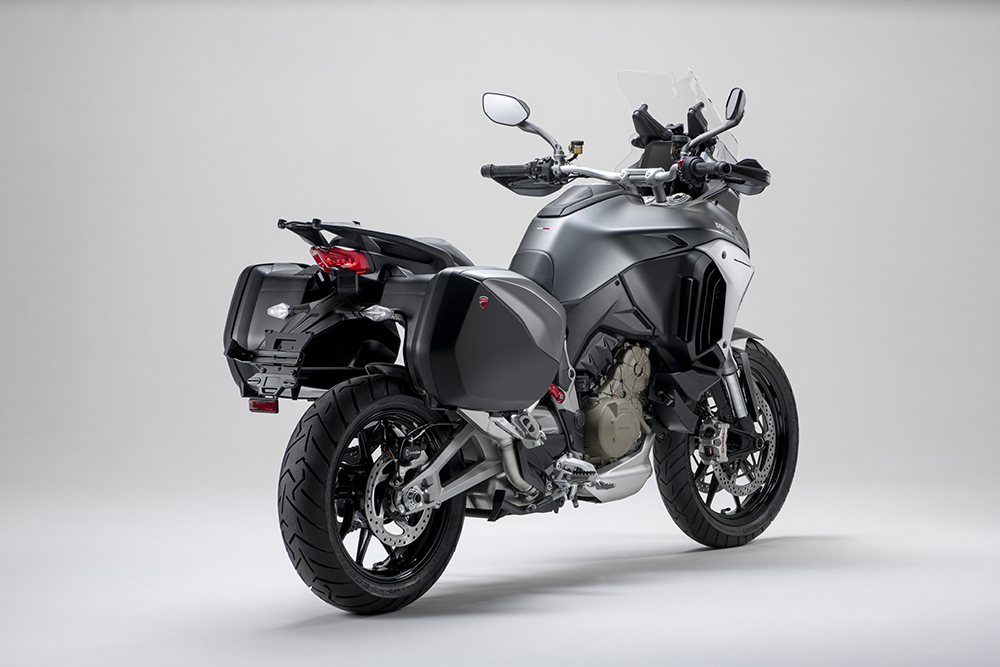This is high-speed adventure touring on a superbike scale
Test Adam Child Photography Ducati
Ducati’s new Multistrada V4 for 2021 is completely different from the now discontinued V-twin Multistrada 1260 – it’s a huge makeover and a big step forward over the previous model, itself an excellent bike.
Virtually nothing remains of the outgoing machine. There’s a completely new V4 engine, a new, lighter chassis, new wheels, including a more off-road oriented 19-inch front. There is also class-leading technology never before seen in the motorcycle market, like rear and forward-facing radar, and a new stunning look and style.
This V4 represents a dramatic attempt to move away from the Multistrada 1290 V-twin, a class-leading adventure bike in its own right.
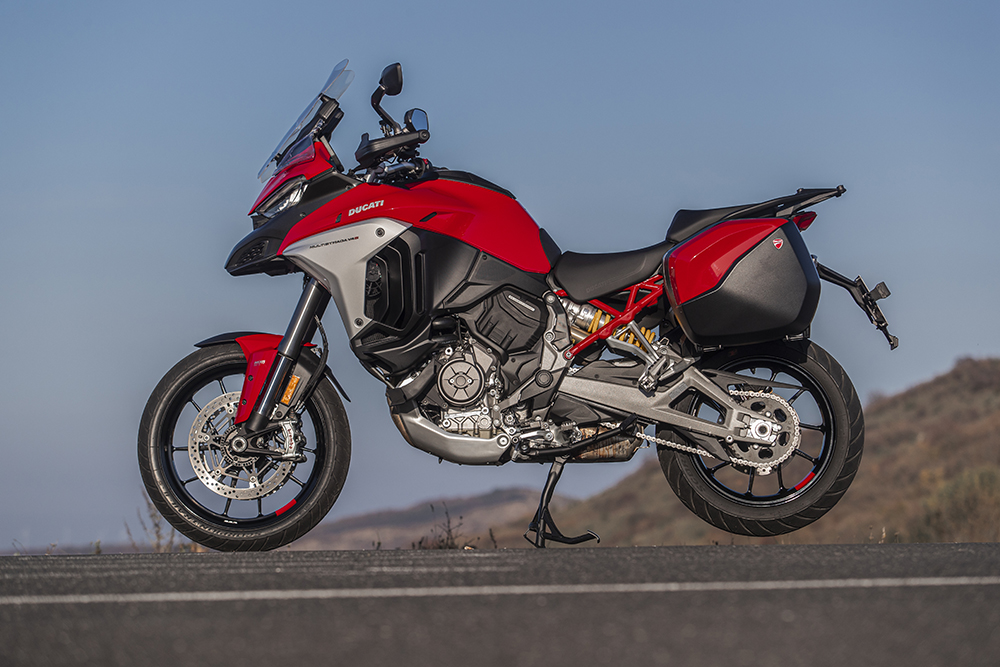
Can you imagine Claudio Domenicali, Ducati MD, at the bike’s original briefing? “Okay, we already produce a world class, market-leading adventure bike, but I want a new and vastly improved one, with a new chassis, new engine, new tech, new look – and I want more off-road ability with a 19-inch front wheel.” A huge ask.
The new V4 is derived from the Panigale superbike with a counter-rotating crank, but very little of that superbike motor remains. The big talking point is the switch to conventional spring-operated valves, rather than desmodromic actuation which has been used on virtually every Ducati since the ’70s. The main reason for this is to extend the service intervals to an industry-leading 60,000km, before the clearances need checking, as opposed to 30,000km on the desmo V-twin.
Compared to the V4 Panigale engine, capacity is up by 55cc from 1103cc to 1158cc, with a larger bore of 83mm, out from 81mm. Peak power of the conventional valve-operated engine is an impressive 125kW (168hp) at 10,500rpm and 125Nm of torque at 8750rpm. Compared to the old V-twin, that peak power figure is up by 7.5kW and, like the torque, higher up in the rev range. Peak torque, however, is down from 131Nm to 125.
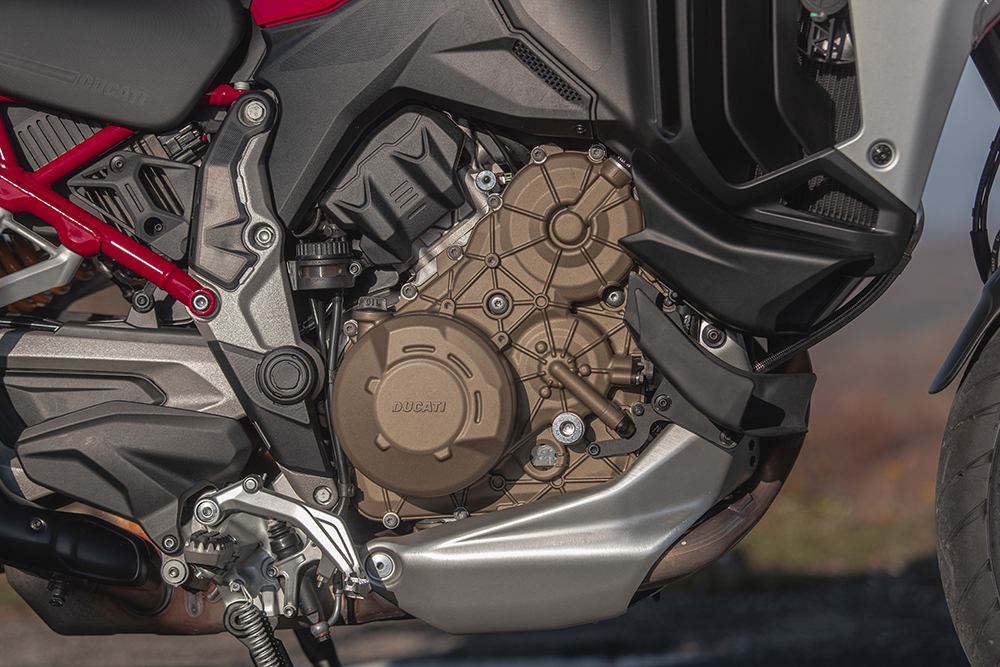
Now, like me, you might be thinking the V4 must be heavier and larger than the twin, but it isn’t. In fact, the new V4 engine is 1.2kg lighter than the previous twin-cylinder; 8.5cm shorter, 9.5cm lower and only 2cm wider. The V4 now sits higher in the chassis, which gives the new Multi 220mm of ground clearance, 46mm more than before.
But it’s not just an adapted, conventional V4 engine, because the Multi has the very latest cutting-edge technology. For the first time on a production motorcycle, the Multistrada is equipped with Adaptive Cruise Control (ACC) as an optional extra, and Blind Spot Detection BSD, which is also an optional extra, made possible by front and rear radar detection.
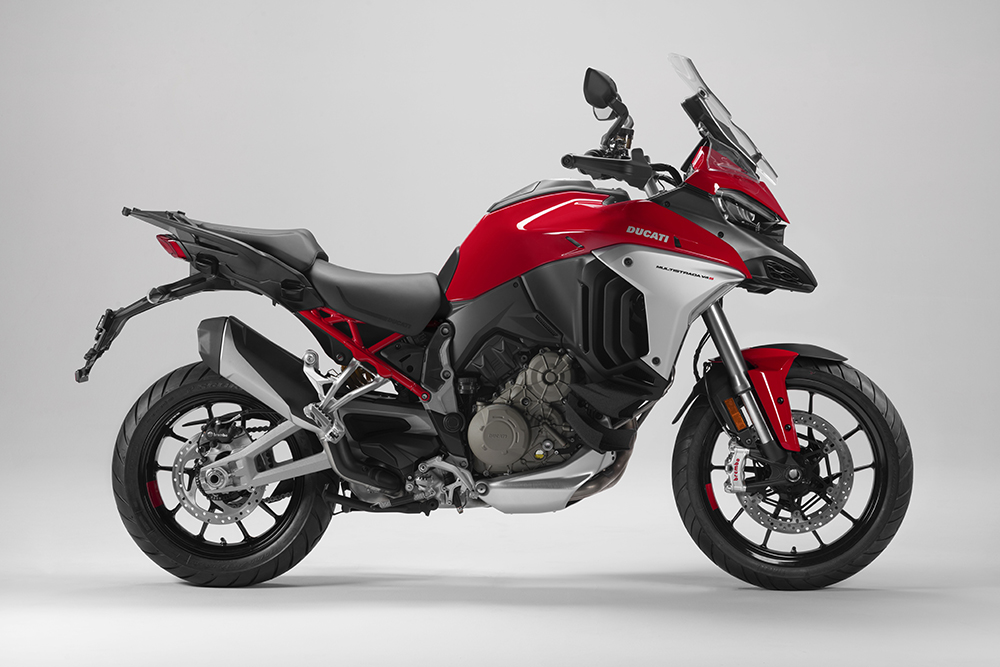
This very clever and simple-to-use system has been designed in partnership with Bosch. If you’re afraid of new tech, don’t worry, it is intended only as an aid – you remain in control of the bike. In basic terms, you set the cruise control at any speed between 30km and 160km, and the adaptive system will control your speed, gently accelerating or decelerating dependant on the information gathered via the radar’s detection.
The blind spot detection uses the rear radar, monitoring vehicles approaching from the rear, and illuminates an LED in the rear-view mirror as a warning. Both systems are similar to what you’ll find in a modern-day car, but this is a first for a motorcycle.

As you’d expect, the new Multi V4 is laden with other advanced rider aids, including cornering ABS, lean-sensitive traction control, wheelie control, cornering headlights and hold control (both standard on the V4 S and optional on the base model) plus multiple rider modes, Sport, Touring, Urban and Enduro. Each mode changes the power, power characteristics, the eight-level traction control, cornering ABS and on the S model changes the base setting of the electronic Skyhook Marzocchi suspension (see boxout).
Relaying all this information is an all-new full-colour dash – five inch on the standard model and six-and-a-half inch on the S. Interestingly, Ducati has also added stability control while the adaptive cruise control is activated, so that means if the bike should encounter a weave, the IMU will detect this and automatically reduce the power to reduce it.

The chassis and dimensions are completely new. For the first time on the over-litre, non-Enduro version Multistrada a 19-inch front-wheel is used, as opposed to the conventional 17-incher on previous models. The rear wheel also reduces in width. This is a major step for Ducati and a clear indication of the new bike’s ability off the road. The second big change is the introduction of a new aluminium monocoque (like the Panigale) chassis with a new trellis sub-frame bolted to it. The chassis is also 4kg lighter than previously. Wheelbase is shorter and there’s a more aggressive, sporty rake and trail – which I’m presuming have been introduced to compensate for the larger front wheel.
I told you this was a dramatic change for Ducati; so much more than just a Ducati Multistrada with a V4 bolted in. For me, extra touches really set a new benchmark and justify the price – every component has been cleverly re-designed or introduced. There is a neat little cubbyhole just behind the fuel cap, which comes with a USB charger and easily accommodates an iPhone. There are further 12-volt sockets upfront and under the seat plus new switchgear, which is backlit. The screen is ‘one finger’ adjustable – ever so easy – and the large full colour dash can be repositioned on the move to stop glare.
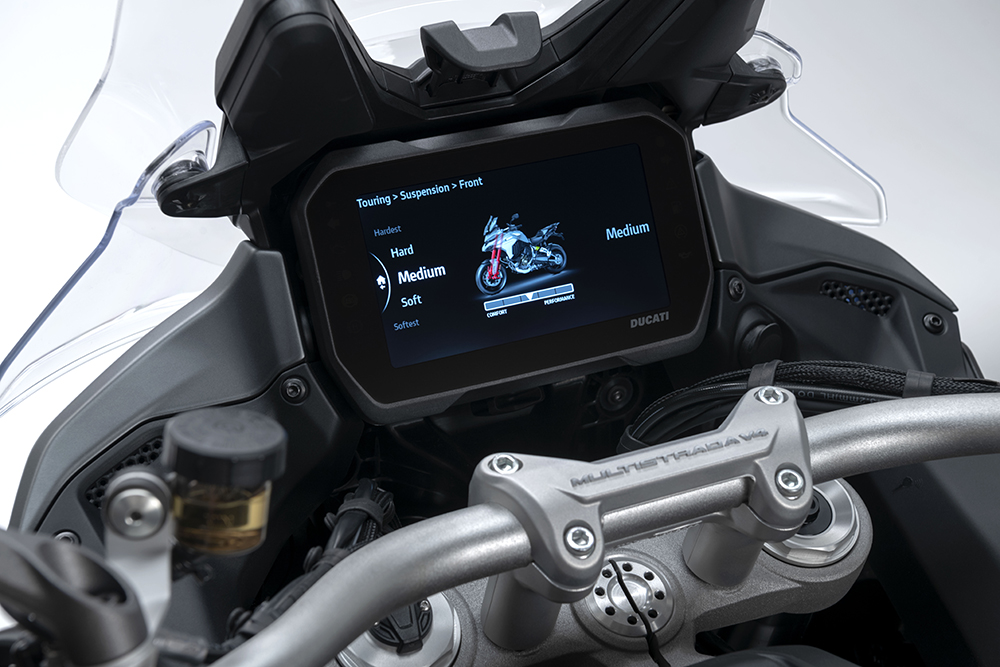
Ducati has thought about the heat generated by the V4, meaning the back two cylinders are switched off at idle to stop heat build-up, and there are additional, neat little gill-like vents on either side of the engine to deflect the heat from the rider. The seat’s height range is slightly taller (up from 825mm-845mm on the old model to 840mm-860mm) but is thinner towards the 22-litre fuel tank, and is easily adjustable. The pillion gets increased comfort and even the option of a heated seat. The optional pannier system is ‘floating’ to allow slight lateral movement, which also increases stability.
Off-road fans won’t be disappointed either. The mirrors are deliberately curved, which means they don’t hit your forearms when you’re standing, while the ’pegs have been designed to allow you to wear bulky off-road boots and have an easy to remove rubber, which requires no tools, giving you plentiful grip off-road.

The detail is outstanding. The Ducati team has certainly been busy. Normally when I arrive to ride a new bike, I can immediately start to find fault, picking away at the details like a vulture on a carcass, but I’m struggling with the new Multistrada. Just when I think they haven’t thought of this or that, it turns out they have.
Even the intake and exhaust are high up so you can ride through deep water, the standard ’bars have multiple-positions better equipped for off-road riding, there are even optional lower and higher seats and, obviously a huge list of accessories which includes carbon accessories, luggage options and an Akrapovic end can – Euro5 compliant, of course.
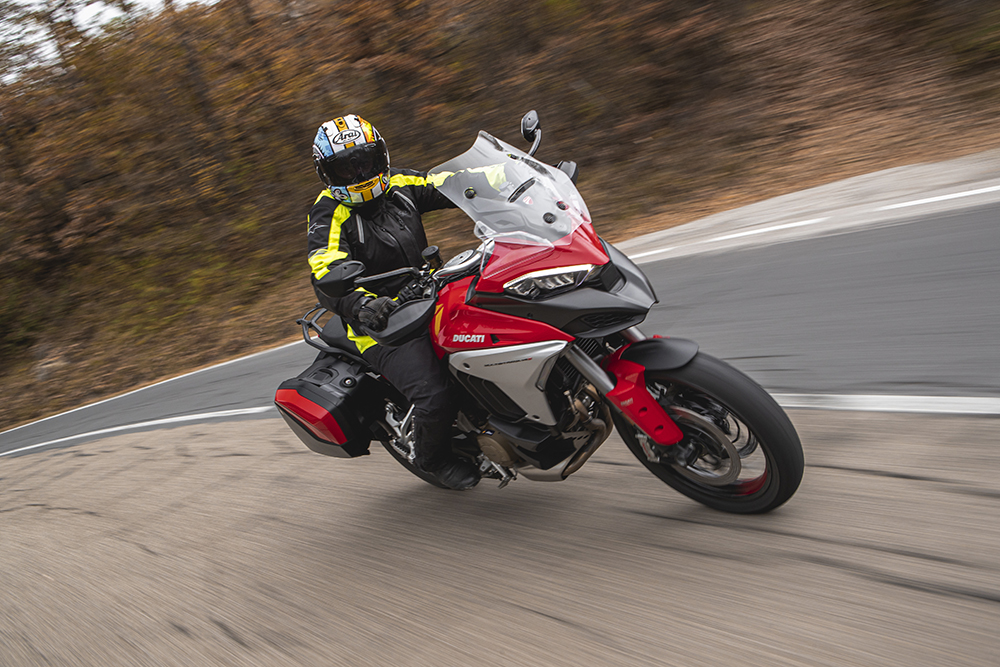
I could talk about design and build of this bike for pages to come, for the rest of the magazine in fact, but the proof is in the riding. Due to Covid restrictions, the exclusive V4 S test ride was out from the Ducati factory in Bologna, which suited the bike perfectly given the excellent roads not too far away from the factory in Northern Italy.
I’m only 170cm, therefore I decided to convert the standard seat to the lowest setting, 840mm, which is done in less than a minute. Then, with the key fob in my pocket, on with the ignition and that full-colour TFT dash comes alive.

A new back-lit toggle switch on the left ’bar enables me to scroll through the informative clocks with ease and choose my specific riding mode. I’ve not had the usual half-hour rider briefing and I’ve not read the manual – but already the clocks feel familiar and intuitive.
Leg over the plush but thoughtfully narrow seat, and I’m almost flat-footed on both sides. With blips of the throttle, the counter-rotating V4 comes alive and has a nice bark. The deactivated rear cylinders at idle are only just noticeable with a clinical ear. A light clutch, into first and we’re away, and the clutch is now redundant as it’s smooth, clutchless changes with the up-and-down quickshifter from here.
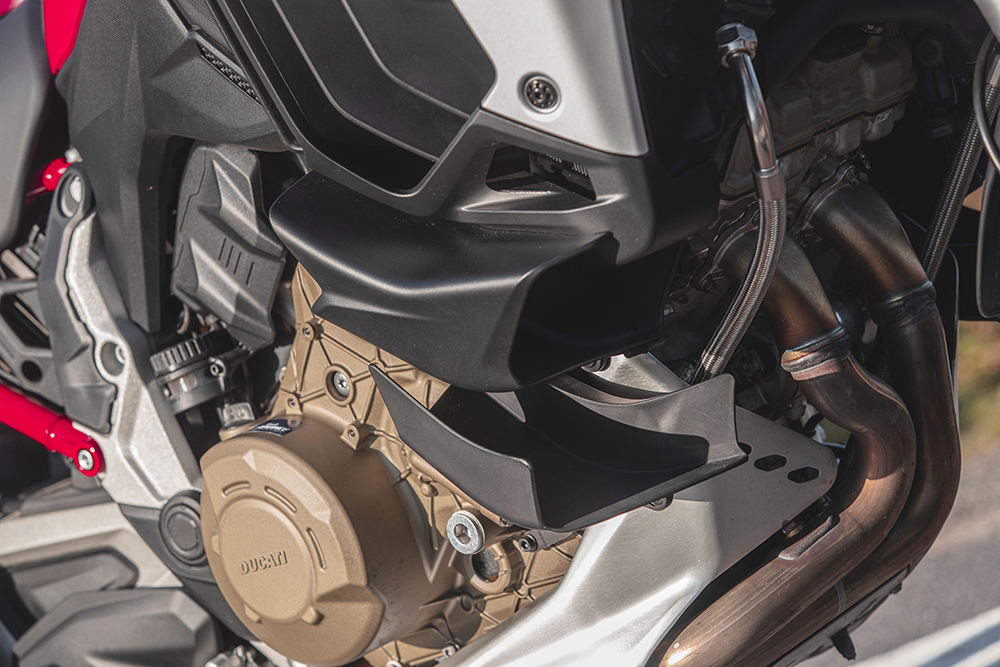
The fuelling is perfect, the engine is smooth, this angry V4 Panigale-derived engine has clearly been living in India for six months studying yoga and chilling out – there’s no angriness about it. At low revs around the city streets of Bologna in the dedicated Urban mode, it’s easy, simple and user friendly. It doesn’t have the top-heavy, intimidating feeling of some adventure bikes, either. Again, I’m only a small rider, but around town this feels more like a Multistrada 950, not an adventure bike with a 19-inch front wheel and a superbike engine.
Leaving Bologna behind and onto the freeway, I flick it into Touring mode. The acceleration onto the freeway is impressive, those 168 Italian horses want to run. Up to cruising speed and this is bliss. With the screen fully upright there is very little wind noise. Even at 160km/h I’m visor-up, no problem.

My first realisation of the radar technology is when I’m riding in the middle lane and the left LED light above the mirror illuminates to warn me a vehicle is approaching from the left. Sure enough, a quick glance in the mirror and over my left shoulder reveals an aggressively driven Alfa Romeo. Wow. The Blind Spot Detection is spotting vehicles approaching from the rear, which I may have missed. Why hasn’t this been done before? Those who distrust technology will be pleased to know you can deactivate the system and even change how far the radar projects backward – but I can’t think why you would ever want to switch it off.
I want to try the Adaptative Cruise Control. I set the cruise control to 140km/h, release the throttle and we’re set. A digital graphic on the bottom right informs me the ACC is working, and I can increase or reduce the range of the radar. I’m slowly getting closer to a car in the middle lane, the radar detects this and reduces power to match the speed of the car in front. I now check my mirror, indicate left, pull out into the outside lane, and we accelerate back up to 140km/h, and I’ve not touched the throttle or brake in the process.
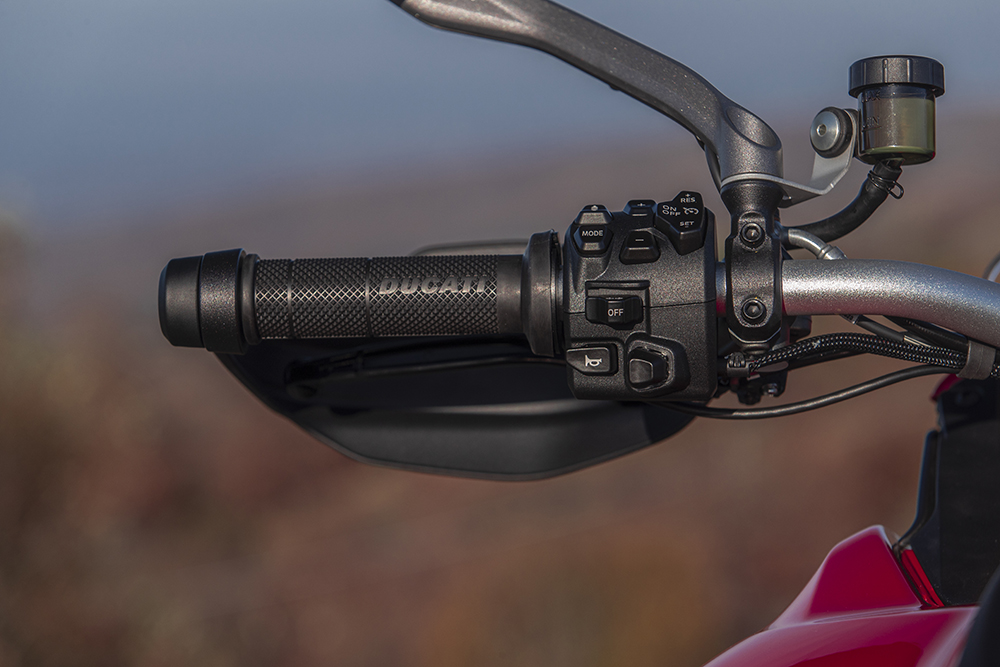
I try to trick the system by riding in the inside lane at 150km/h, approaching slow-moving trucks at speed. But, again, the radar detects the vehicle and the difference in vehicle speed, reduces the power and applies some gentle braking. I can then choose to follow the truck at a safe, radar-controlled distance or switch lanes and automatically accelerate.
It’s worth noting that the system is only working when you’ve selected cruise control; touch either brake or the throttle and it’s automatically cancelled. The system is similar to those found on many cars but is very well adapted for two wheels, and the only slight downside is that I noticed it struggles to detect other motorbikes, which are much narrower than cars/vans/trucks.
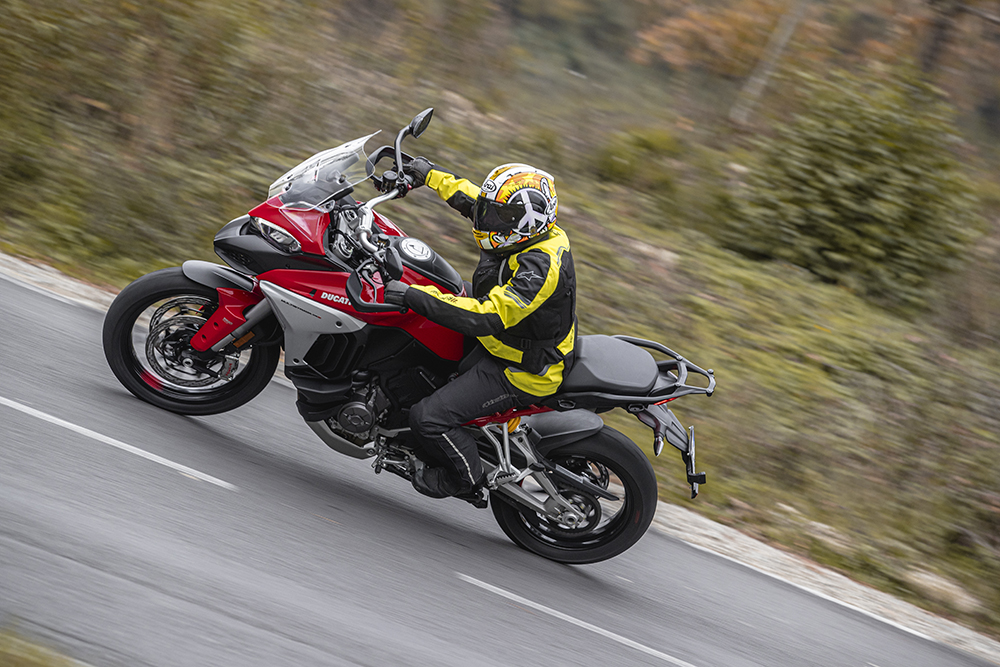
Away from the gadgetry, comfort is excellent. The Skyhook ride is forgiving and there is little vibration despite the V4 cruising along at 160km/h with ease. Sixth gear is tall, but at that speed I thought the revs would be a little lower, and in this respect, it will be interesting to see how it compares to the competition. Ducati has upped the fuel tank capacity to 22 litres to presumably compensate for the thirstier V4. Ducati claim 6.6L/100km and on the test I averaged around 7L/100km, though the pace was brisk. Thankfully the Multi V4 isn’t going to be as thirsty as Ducati’s other V4 models, as they drink faster than a drunk in happy hour after a two-month lockdown.
The quoted tank range should be 335km, with 300 a more realistic estimate, meaning you are going to start needing to look for fuel around 260 clicks. Is that enough for a big adventure tourer?
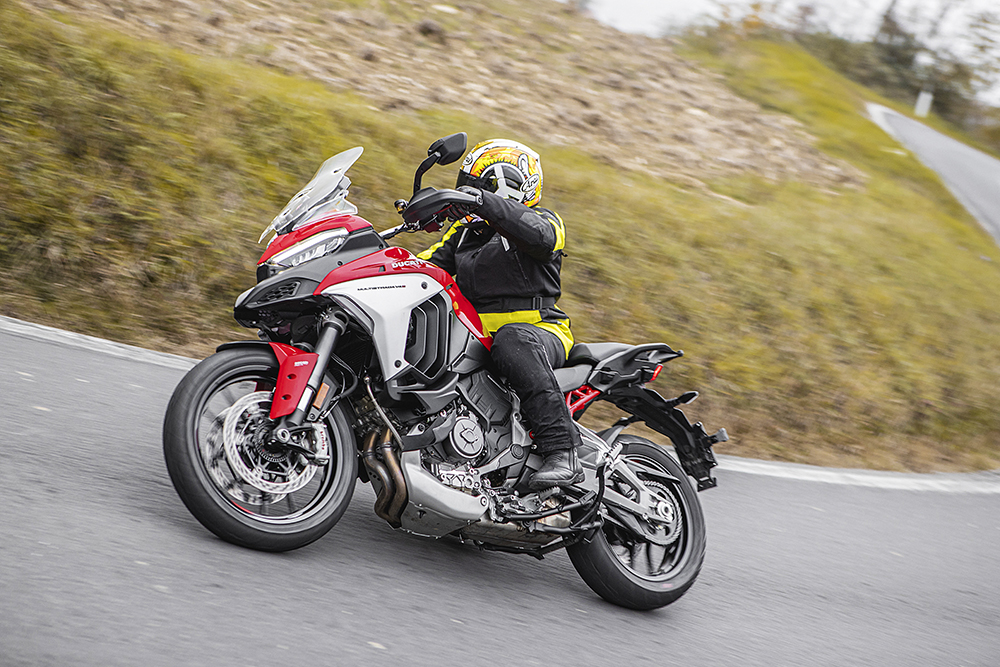
The mountain passes in northern Italy were calling and, despite excellent comfort and wind protection, I couldn’t wait to flick into Sports mode and test the handling. Fitting a large 19-inch front tyre should noticeably slow the steering, but the rear is now a smaller 170-section, down from 190, the wheelbase is shorter and the rake and trail more aggressive, not forgetting a lighter chassis and engine. Overall weight is a little more than the V-twin depending on the model and spec, and the exhaust is now heavier, throttle bodies have doubled in number, there is more wiring and technology… But even so the best compliment I can bestow is that the new Multi handles and feels like a bike with a 17-inch front wheel.
The steering is excellent. It does not steer like a 243kg (kerb, claimed) adventure bike with a 19-inch front tyre. Instead, it is accurate and relatively easy to throw around and change direction at speed. Excellent cornering ABS and Brembo Stylema brakes are always on hand if you should dive in a little too hot.
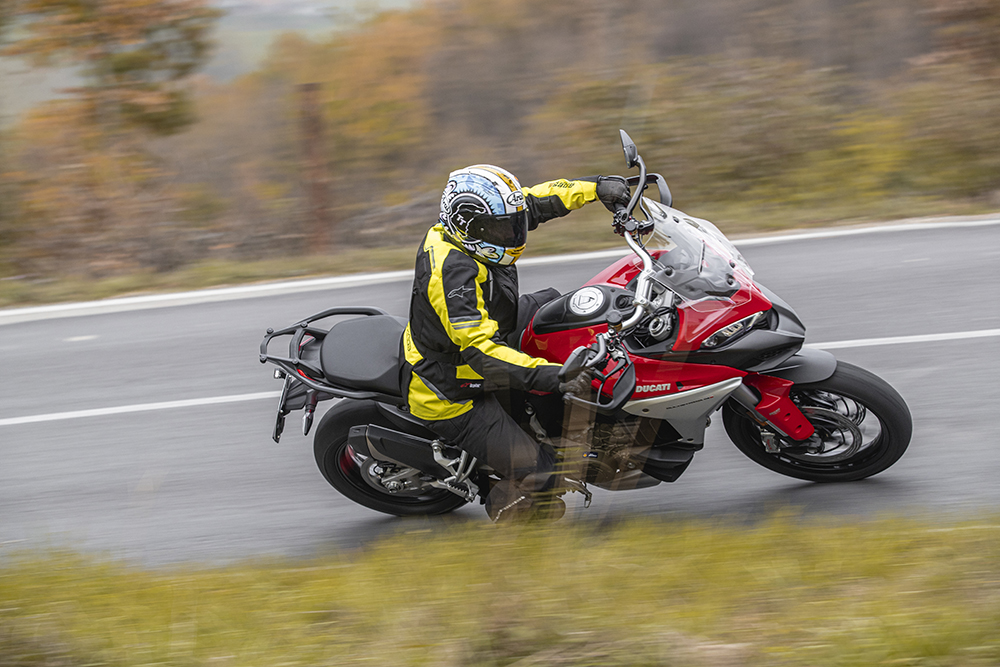
Ground clearance is impressive, even in fast cornering I didn’t have any issues and the feedback and grip from the Pirelli Scorpion Trail 2 rubber, which has been designed in partnership with Ducati for this model, are spot on.
I personalised the Sport mode, reduced the TC and turned off the wheelie control. Grip in the dry is excellent and there’s enough power for the odd effortless wheelie over crests and out of tight corners. Let’s not forget there is some serious power, that V4 wants to run.
In Sports mode, the Skyhook suspension really comes into its own. I deliberately pushed hard on uneven roads and the new Multi delivered.
The 50mm-diameter fork’s control is impressive, but possibly more so is the rear, which stays planted and under control. You hit an undulation hard on the power and you can feel the rear compress and the tyre grip, but then it controls the rebound and – importantly – doesn’t recoil too quickly reducing the push/grip to the rear Pirelli. There is 180mm of travel on the rear, 10mm more than before, but it’s superbly controlled. A well ridden Multi would give a sportsbike a run for its money on the right road.

As the temperature dropped, it was (optional) heated grips on and time to head back to the factory via the freeway. Even after a full day in the saddle, comfort was still excellent. The wind protection and lack of wind noise meant I didn’t even bother with earplugs.
In Touring mode, the suspension becomes more compliant compared to Sport, and again the rear radar detection was spotting fast Italian drivers whizzing down the outside lane at speed, despite the fact I was cruising at 145km/h. Back into Bologna, now careful of the fitted panniers, Urban mode noticeably softens the suspension, gives more fluidity and reduces the power. This really is a bike for all occasions.
For 2021 the Multistrada is now more versatile than ever, it truly is four bikes in one: capable off-road, comfortable for touring, it can make you smile in the mountains and is relatively easy to live with and use around town. Adding a larger front wheel hasn’t hindered the fun and has vastly improved its off-road capabilities.

As with all Ducatis, it’s desirable and good looking and there’s a huge list of trim and accessory packs, which means you can personalise the bike to fit the way and where you ride straight out of the showroom. Fuel consumption is higher than the competition and, for some, tank range may not be enough. It’s not cheap, but service costs are low, and the price is, mostly, justified by the quality and technology.
I want to be able to really push the boundaries off-road, but as a first taste – it’s hugely impressive.
